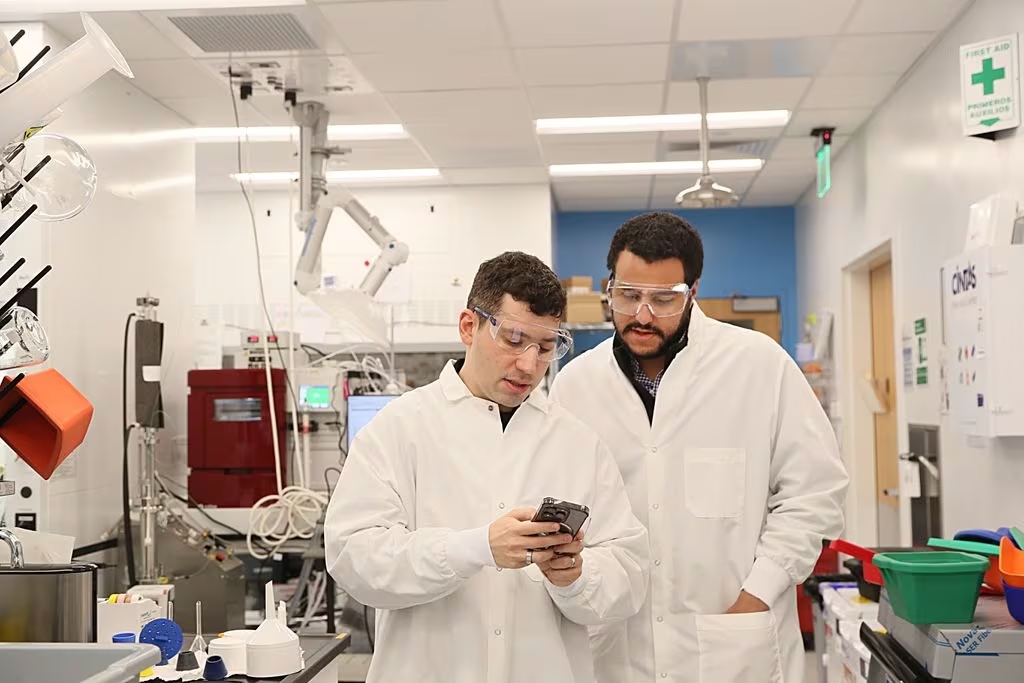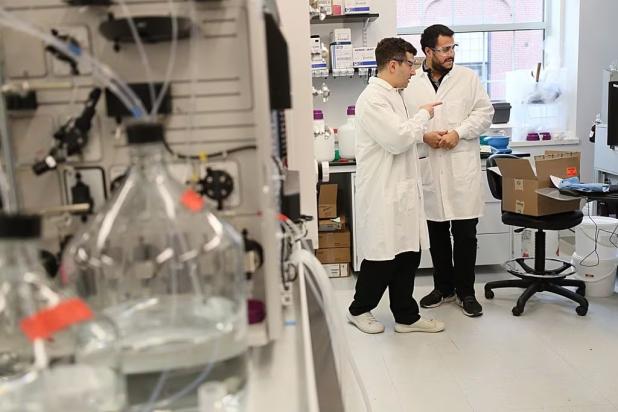
Jonathan Gootenberg, left, and Omar Abudayyeh, cofounders of Tome Biosciences, a Watertown startup that reengineers genes and cells to cure diseases.Suzanne Kreiter/Globe Staff
The following story was published in the Boston Globe. Omar Abudayyeh is a 2018 HST Medical Engineering and Medical Physics (MEMP) PhD alumnus.
Friends since MIT days, Omar Abudayyeh, an HST MEMP alum, and Jonathan Gootenberg, jointly run a Harvard lab and cofounded a gene-editing startup
Robert Weisman | Boston Globe
WATERTOWN — Their brainstorming began in an MIT class in 2010 when the eager undergrads shot each other emails about how to solve a bioengineering equation. It has continued for 14 years over sushi dinners, between Marvel movies, and during rowing-machine workouts.
Together, Omar Abudayyeh, 33, and Jonathan Gootenberg, 32, have probed the mysteries of genomic editing and COVID detection. They co-published 10 scientific papers, helped launch two medical-diagnostic companies, and cofounded a Watertown startup, Tome Biosciences, that reengineers genes and cells to cure diseases. They also run the Abudayyeh-Gootenberg Lab at Harvard. Abudayyeh graduated from the Harvard-MIT Program in Health Sciences and Technology (HST) with a PhD in Medical Engineering and Medical Physics (MEMP) in 2018.
Gootenberg and Abudayyeh are an unusual pair, two scientists — a Jewish American and a Palestinian American — who prefer working together in a field that often draws solitary researchers and rewards individual achievement.
Even as Israel’s war in Gaza has raised tensions worldwide, including in Massachusetts, there’s no tension in their partnership. Both scientists said they support a peaceful end to the conflict. But while saying they’re on the same page, they declined to discuss their views in any detail.
“We’re here to make medicines for the betterment of humanity,” said Abudayyeh. “That’s literally what we spend 12 or 14 hours a day working towards every day. So I don’t think it’s a surprise that we’re going to be on the side of peace and hoping that, for everyone, pain can be alleviated.”
“In our friendship,” Gootenberg added, “we are politically aligned centrist people. We don’t have any sorts of disagreements. Whatever kind of symbol we can be for progress, peace, that’s certainly heartening.”
The two men are part of a tight-knit academic and research community. Gootenberg began dating his now-wife, Yoonjeong, when they were MIT students; they have two sons, a toddler and an infant. Abudayyeh met his wife, Julia, in a research lab where Gootenberg also worked. The two families live in the same neighborhood, near Central Square in Cambridge, and get together for meals, events, and parties.
In their professional lives, Abudayyeh and Gootenberg are proteges of Feng Zhang, the gene-editing pioneer at the Broad Institute of MIT and Harvard, with whom they partnered to start Sherlock and Proof, two companies that use a gene-editing technology called CRISPR to generate rapid diagnostic tests.
Over the years, Gootenberg and Abudayyeh bonded over their quest to tackle science’s toughest problems. As their partnership evolved, so did their friendship. They’ve taken part in one another’s weddings and traditions, making latkes and jelly doughnuts for Hanukkah, and sharing food at the Iftar fast-breaking meal during Ramadan.
Whether shuttling between their lab’s two locations, in Boston’s Longwood Medical Area and Cambridgeport, or visiting the offices of Tome, their gene-editing startup, Gootenberg and Abudayyeh have become as well known in science circles for their friendship as their research and business ventures.
“Science is difficult, and it’s great to have someone to do it with,” said Gootenberg. “You got to work with people you enjoy hanging out with.”
Robert Desimone, director of MIT’s McGovern Institute for Brain Research, tapped Abudayyeh and Gootenberg in 2019 as the inaugural McGovern Fellows, a program that gives post-doctoral researchers the time, space, and financial support to pursue their own scientific inquiries.
From the beginning, the pair stood out because unlike some researchers, who prefer to work alone, Abudayyeh and Gootenberg did everything together, Desimone said. They ran a joint lab for four years at the McGovern Institute — people there called them “Jomar,” a mashup of Jonathan and Omar — until they got their Harvard faculty appointments.
“They were a little bit like the kids in the candy shop,” Desimone said. “When they came here as fellows, they decided they were going to run an integrated lab. It’s really rare to have people who collaborate that closely on everything.”
Abudayyeh, who left medical school to pursue science and entrepreneurship, grew up in Kalamazoo, Mich., where his father taught civil engineering and his mother taught electrical engineering at Western Michigan University. His parents were born in the West Bank but worked in Kuwait before immigrating to the United States. He has family in Jordan, Saudi Arabia, and Kuwait, and has visited the Middle East many times.
Growing up, Abudayyeh recalled, “I was around a lot of hard-core engineering. My mom did digital signal processing. After school in my dad’s lab, I played with bridge design software as a 10-year-old.”
Gootenberg grew up in the Maryland suburbs of Washington, where his father was a hematologist oncologist and his mother a doctor of internal medicine. As a child, he toured the National Institutes of Health campus. His parents later worked for the Food and Drug Administration.
When they met in the MIT bioengineering class, Gootenberg and Abudayyeh were undergrads, uncertain of their future. Their paths took a turn toward more serious science when they later reunited in neuroscientist Ed Boyden’s lab at MIT. There they worked with a team on a project using protein sequencing, a technology important to understanding how cells work. The project, while unsuccessful, gave them a taste of the thrill of cutting-edge research collaboration.
When they met in the MIT bioengineering class, Omar Abudayyeh and Jonathan Gootenberg were undergrads, uncertain of their future.Simon Simard/Bloomberg
“They both pushed the boundaries of things, and they liked working together,” said Fei Chen, a former lab colleague who now runs his own lab at the Broad Institute and remains friends with Abudayyeh and Gootenberg. “They have a complementary approach to problems in the lab.”
Chen said they’re also comfortable challenging each other’s approaches. They argue about designing cell and gene therapies, or the impact of artificial intelligence. “They kind of squabble a little bit, like a married couple, when you hang out with them,” Chen said.
But Gootenberg and Abudayyeh are both laser-focused when it comes to work. Chen recalls a Super Bowl party in 2020, when the COVID pandemic was still largely confined to China but expected to spread. During the game, the Broad’s Feng Zhang called Abudayyeh and Gootenberg to ask if they could come to the lab to help with a COVID detection experiment. “They said, ‘Oh, we got to go,’ ” Chen recalled.
Today, Gootenberg and Abudayyeh hope Tome will be developing therapies that can be approved by the FDA to vanquish a broad range of cancers and autoimmune diseases.
Tome is deploying a next-generation form of gene editing called programmable genomic integration, or PGI. Earlier versions of gene editing sought to cut out a single mutation that affects a subset of patients. By swapping out an entire gene, PGI aims to fix multiple mutations that may play roles in the same disease and help more patients. The prestigious science journal Nature cited it as one of “Seven Technologies to Watch in 2024.″
If their approach is successful, the process could be replicated to treat many diseases, a potential breakthrough in genetic medicine, Abudayyeh said. “We really wanted to create . . . a new way of doing these therapies to make a real impact on human life,” he said.
The partners retain a childlike enthusiasm for solving problems — the tougher the problem, the better. As students, they were part of a design project to screen the microbiome, a little-understood habitat of microorganisms, for bacteria that could reverse inflammatory diseases. Years later, working with Zhang, they applied their analytical skills toward discovering new tools for editing genes.
“When you’re young, you think you can do anything,” Gootenberg said. “You work on hard concepts. The real magic is finding that intersection of almost impossible but feasible. You don’t want to go for that easy stuff. You’re throwing your brain at stuff, and we still do that today.”

Jonathan Gootenberg, left, and Omar Abudayyeh have copublished 10 scientific papers, helped launch two medical-diagnostic companies, and cofounded a Watertown startup, Tome Biosciences.Suzanne Kreiter/Globe Staff
* Originally published in the Boston Globe.